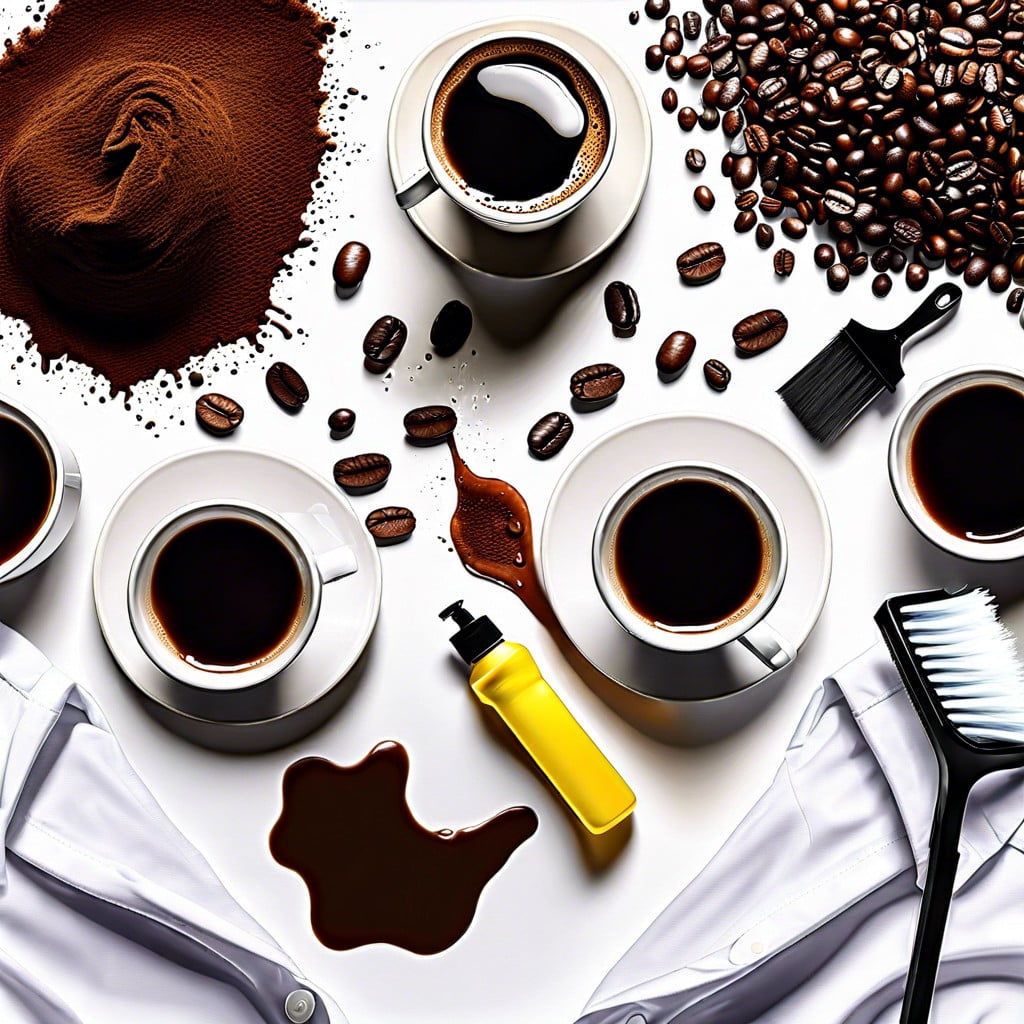Discover effective methods to banish coffee stains from your favorite fabrics.
What You’ll Need

Before tackling the stubborn brown blemish on your favorite shirt or plush carpet, gear up with these essentials:
- Cold water: The first line of defense, ready to dilute the stain.
- Clean, white cloths or paper towels: For blotting, not rubbing, to avoid spreading the stain.
- Liquid laundry detergent or dish soap: Acts as a gentle but effective stain lifting agent.
- White vinegar: A household hero that breaks down the coffee pigments.
- Baking soda: Absorbs and helps lift stains when mixed into a paste.
- Commercial stain remover: For those particularly persistent stains.
- Toothbrush (optional): Handy for working the cleaning solution into the fabric fibers.
- Patience: Tackling stains can be a test of resolve, so take a deep breath.
Remember, the quicker you act, the better your chances of making that coffee stain history.
Instructions for Removing Coffee Stains From Fabrics
Blot the stain with a dry cloth to absorb any excess coffee. Avoid rubbing, as this can spread the stain.
Rinse the stain with cold water from the back of the fabric to push the coffee out of the fibers.
Apply a pre-treatment stain remover or a small amount of liquid laundry detergent. Gently work it into the stain with your fingers or a soft-bristled brush.
Let it sit for 3-5 minutes. For persistent stains, soak the fabric in warm water for 30 minutes to an hour.
Wash as usual, according to the fabric care instructions, using the warmest water safe for the fabric.
Before drying, check that the stain is completely gone. Heat can set the stain, making it harder to remove.
If the stain remains after washing, repeat the steps above before drying.
How to Remove Coffee Stains From Carpet and Upholstery
Spilled your morning brew on the carpet? No need to cry over spilled coffee. Dab it gently with a clean, dry cloth to absorb as much liquid as possible. Avoid rubbing – you don’t want to push the coffee deeper into the fibers.
Next, mix one tablespoon of liquid dish soap, one tablespoon of white vinegar, and two cups of warm water. Using a clean cloth, apply this solution directly onto the stain. Blot the spot from the outside in, preventing the stain from spreading. Rinse by dabbing with cold water and blot until dry.
For stubborn stains, switch to a solution of one part hydrogen peroxide and two parts water. Test on an inconspicuous area first to make sure it’s safe for your fabric. Apply sparingly and blot until the stain fades. Rinse with cold water and dry.
For upholstery, check the manufacturer’s label for cleaning instructions. Use a commercial upholstery cleaner if your fabric is delicate and remember – test it on a small, hidden area first.
React quickly to coffee spills to improve your chances of avoiding a permanent reminder of your caffeine fix. Regular vacuuming can help maintain the cleanliness of your carpet and upholstery, making it easier to lift stains when they do happen. If the stains persist, consider hiring a professional cleaning service. Keep in mind, like a good espresso, quick pressure in the right spots can make all the difference.
Additional Tips for Handling Coffee Stains
Tackling coffee spills swiftly increases your success rate in banishing them. Cold water often does the trick; pour it over the stain and let it run through the fibers. Blotting, not rubbing, is the golden rule here—rubbing can make the stain set deeper.
For on-the-go incidents, portable stain removal pens can be lifesavers. Keep one in your bag or car for those coffee-related emergencies. If you’re out of commercial cleaners, white vinegar and baking soda create a handy homemade solution. Just apply, let it sit for a moment, then rinse.
Ironically, sometimes coffee can hide in plain sight. If you have dark or patterned fabrics, inspect them under good lighting to catch sneaky spots.
Remember, heat sets stains, so avoid hot water and high dryer settings until you’re certain the stain is history. Lastly, patience is truly a virtue with stain removal. Some stains require several treatments, so keep at it, and your persistence will pay off.